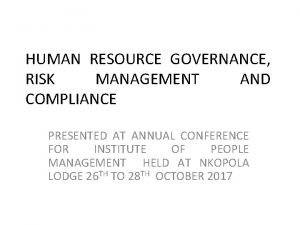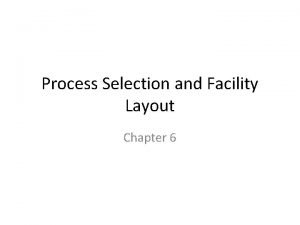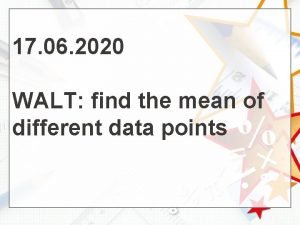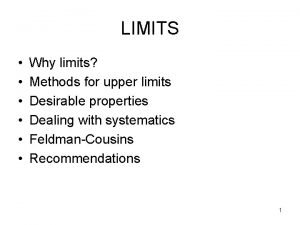Risk and the Limits of Governance Exploring varied


















- Slides: 18

Risk and the Limits of Governance: Exploring varied patterns of riskbased governance across Europe Henry Rothstein King’s College London How. SAFE: How States Account for Failure in Europe A collaborative project between King’s College London, Sciences-Po, Bielefeld University and Maastricht University funded through the Open Research Area programme for the social sciences jointly funded by the ESRC, DFG, ANR, and NWO. Website: tinyurl. com/HOWSAFE-PROJECT Original Article: H. Rothstein, O. Borraz and M. Huber (2013) R Risk and the limits of governance: Exploring varied patterns of risk-based governance across Europe. Regulation and Governance. DOI: 10. 1111/j. 1748 -5991. 2012. 01153. x 1

Risk-Based Governance • Risk has become central organising principle for governance. • Premised on simple idea that governance cannot, and should not, aim to eliminate all ‘adverse outcomes’. • Instead, need to pay attention to ‘probability x impact’ to focus efforts on reducing harm to socially optimal levels. 2

Risk-Based Governance • Organizing governance through risk promises to improve its quality, efficiency and rationality. Ø Information gathering Ø Setting standards Ø Behaviour change activities • But how far do ideas of risk-based governance travel across countries? 3

UK ‘Risk’ discourses have displaced traditional policy discourses of defence, safety and security. In principle, favours: • Neo-liberal commitment to economically rationalized “Better Regulation” • Legitimates decision-making in face of new accountability and audit cultures; • Limits blame by defining boundary between acceptable “risk is central to the business of & unacceptable adverse outcomes. good government” –Tony Blair (2002) 4

Occupational Health and Safety Tolerability of Risk, UK Health & Safety Executive Risk cannot be justified except in extraordinary circumstances ‘ALARP’ As Low As Reasonably Practicable Tolerable only if risk reduction is ‘grossly’ disproportionate to cost Risk broadly acceptable (From Rimington 1993) 5

Criminal Justice ‘Legislative changes and policy initiatives have made risk assessment and risk management core tasks for National Offender Management Service’, e. g: - Extended use of custody for 'dangerous' offenders and preventative sentencing on the grounds of risk. - Extended monitoring and surveillance of those offenders presenting a high risk of harm in the community and upon release from prison. 6

National Security 7

Germany • ‘Risk’ central to German political debate, from nuclear power to GMOs. Federal Institute of Risk Assessment (Bf. R) provides risk-based scientific advice on consumer issues, from BSE to toys and lipsticks. But risk-based approaches have not penetrated very far into policymaking and enforcement practice because… 8

Danger vs. Risk • State’s ‘duty of protection’ from ‘dangers’ to life, freedom & property (Schutzpflicht). Constitutional principal that’s colonised policy domains from nuclear safety to rented accommodation • Binary concept: No danger = no state action. • Juridified German public administration finds it difficult to use ‘probability-x-impact’ frameworks to define boundary between unacceptable ‘dangers’ and acceptable ‘risks’. 9

Acceptable Risk? Danger Hard to define acceptable risk levels Residual risk 10

Intractable legal conflicts Conflicts over acceptable risk throughout 1970 s-80 s. • Some administrative courts defined acceptable probability of an accident as 10 -7/yr, while the federal constitutional court attempted to define it in terms of being ‘practically unimaginable’ and ‘irrelevant’. • Federal constitutional court decides to abstain from decisions on scientific conflicts or disagreements. 11

Risk vs Rights • Probabilistic boundaries between unacceptable ‘danger’ and acceptable ‘residual risk’ are set. . . • But State’s ‘duty to protect’ all citizens from dangers hard to reconcile with risk-based interventions. Makes calculations blind to impact. E. g. State (in principle) protects citizens against floods that occur > 1/100 years by building defences or forbidding development. But is irrespective of whether urban centres or rural areas. 12

Expertised / Corporatist Solutions • Solutions sought through corporatist governance traditions and expert committees; • Avoids legal conflicts and spreads responsibility for adverse outcomes. 13

Country Variation Acceptability of adverse outcomes Unacceptable Acceptable Low Type-1) Reactive, ‘fire-alarm’, Type-2) ‘Business as usual’ responses if, and when, responses to adverse outcomes become manifest France Transparency of, and accountability for, adverse outcomes Type-3) Responsibility/Blame Type-4) Ex-ante risk-based -sharing strategies for routine approaches for routine disclosure of adverse outcomes Germany UK High 14

Regime Variation Acceptability of adverse outcomes Unacceptable Acceptable Low Transparency of, and accountability for, adverse outcomes Type-1) Reactive, ‘fire-alarm’, Type-2) ‘Business as usual’ responses if, and when, adverse outcomes become manifest responses to adverse outcomes UK: National UK: Social Care Security Type-3) Blame-deflection Type-4) Ex-ante risk-based strategies for routine disclosure of approaches for routine disclosure of adverse outcomes High 15

Variation within Regimes by Function Acceptability of adverse outcomes Unacceptable Acceptable Low Transparency of, and accountability for, adverse outcomes Type-1) Reactive, ‘fire-alarm’, Type-2) ‘Business as usual’ responses if, and when, adverse outcomes become manifest responses to adverse outcomes Type-3) Blame-deflection Type-4) Ex-ante risk-based Pre-BSE food safety policy strategies for routine disclosure of approaches for routine disclosure of adverse outcomes High Food Safety Act (standard-setting) Food safety inspection 16

How. SAFE Comparative Framework Flooding Food safety Occupational Health & safety Health care Education Criminal Justice 17

Paper forthcoming in Regulation & Governance. doi: 10. 1111/j. 1748 -5991. 2012. 01153. x tinyurl. com/HOWSAFE-PROJECT For further information contact: Henry. rothstein@kcl. ac. uk 18
 Limits involving infinity
Limits involving infinity Real limits vs. apparent limits
Real limits vs. apparent limits Liquidity measures
Liquidity measures A healthful diet is adequate moderate balanced varied and
A healthful diet is adequate moderate balanced varied and Data governance and risk management
Data governance and risk management Oracle governance risk and compliance
Oracle governance risk and compliance Hr governance risk and compliance
Hr governance risk and compliance Microsoft 365 governance risk management
Microsoft 365 governance risk management Outline vs contour line
Outline vs contour line What is an adverbial opener
What is an adverbial opener Minimum cycle length
Minimum cycle length What is varied sentence structure
What is varied sentence structure Varying sentence starters
Varying sentence starters Varied climate
Varied climate Varied expertise
Varied expertise What does varied fluency mean
What does varied fluency mean Integrated governance risk compliance platform
Integrated governance risk compliance platform Residual risk and secondary risk pmp
Residual risk and secondary risk pmp Business risk and financial risk leverage
Business risk and financial risk leverage


































